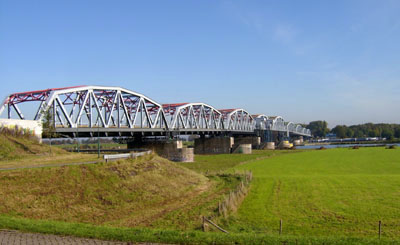The Old Church

Many soldiers came back from Arnhem without having reached the bridge. Of these soldiers, from many different battalions, one new unit was formed. This unit was named
Lonsdale Force, after Major Richard Lonsdale who commanded the unit. The
Lonsdale Force defended the south-eastern corner of the perimeter and was constantly attacked by German troops. On Wednesday 20 September, the Lonsdale Force withdrew to the Old Church.
When the British units gave up their attempt to reach the bridge in Arnhem and withdrew to Oosterbeek, the Old Church was the first place where they could catch their breath. The
Lonsdale Force was 500 men strong at this time and had three 17-pounder cannons at its disposal. This huddled group succeeded in keeping their positions near the Old Church until the evacuation over the Rhine.
The white house across the Old Church was the rectory which was inhabited by Jan and Kate ter Horst. During the Battle of Arnhem, the rectory became a medical post where hundreds of wounded were taken care off. The rectory and the Old Church were on the front line. This made it impossible to bury the deceased. After the battle, in the backyard of the rectory, a field grave was found with the bodies of 57 deceased soldiers.
White Ribbon MileLess known and often overlooked is the difficult and rapid withdrawal of soldiers from the perimeter in Oosterbeek to the Rhine. The challenging conditions under which this retreat took place are also frequently forgotten. In the dead of night from Monday, September 25 to Tuesday, September 26, 1944, over 2,300 soldiers had to retreat across the Rhine near Driel. This evacuation was codenamed Operation Berlin.
White ribbons along the route, made from parachutes, marked the path to the river. These ribbons became a lifeline for the soldiers. Losing sight of the ribbon or losing contact with the soldier ahead of you could mean getting lost or worse. A ribbon became a lifeline for these ordinary young men, these soldiers. Exhausted from the battles, they had to make their way through forests and floodplains to reach the banks of the Rhine. They were out of ammunition, hungry, and severely sleep-deprived. In the pitch-dark night, under pouring rain and relentless artillery fire, they had to find their way. They had lost an illusion as the Battle of Arnhem and the occupation of the bridge had failed. It was also heartbreaking to leave behind a devastated village and its wounded comrades. Almost all the remaining soldiers, predominantly British, gathered near the Old Church by the Rhine to attempt the crossing.
The Poles near DrielOn the south side of the Rhine, near the church tower, lies the village of Driel. On 21 September, over 1.000 Polish paratroopers landed here. The Polish soldiers, led by General Sosabowski, had to cross the Rhine to support the British troops in the perimeter.
The Polish brigade had been promised a ferry with which they could cross the Rhine to reach the British. Once in the Netherlands, however, the ferry proved to be unavailable. During the evening, the Polish troops attempted to reach the other side with a few rubber boats. The crossing was dangerous. The boats came under heavy German fire and the operation had to be abandoned. Only 150 soldiers managed to reach the other side.
Although only a small part of the Polish brigade could support the British troops, their presence was of great importance. The dropping of the Poles south of the Rhine caused the Germans to split their forces, not only to attack the perimeter but also to defend the road from Arnhem to Nijmegen. In addition, the Polish troops who managed to reach the perimeter provided much-needed relief and reinforcement.
Tafelberg
On Monday September 18, Van Maanen was accompanied by two medical officers of the British troops. They set up the Tafelberg as an operating point. During the first 48 hours of their stay, the officers carried out more than 60 operations. On Thursday 21 September, it was no longer possible to operate in the operation rooms. Due to continuous shootings, the ceilings of the rooms collapsed, but there were still plenty of wounded who needed help. In order to be able to operate, stretchers were placed on the billiard tables and served as operating tables.
On Sunday 24 September, about 1,200 wounded men were inside the perimeter. Chief Medical Officer, Colonel Graeme Warrack, managed to negotiate a short truce with the German troops to evacuate the wounded. For a few hours, it was possible to move the severely wounded soldiers from the Tafelberg and Hotel Schoonoord by jeep and stretcher to the St. Elisabeths Gasthuis and a hospital in Apeldoorn. However, this meant that these wounded soldiers were automatically made prisoners of war. The heavily injured soldiers at the medical posts elsewhere within the perimeter were not allowed to be evacuated. They had to remain there until the end of the battle.




















